There is a tendency to think of wildlife as furry and warmblooded. But, close relatives though we may be to mammals, and even though fox and raccoons are fascinating, they are not the only inhabitants of the wild side of the Outer Banks.
Explore any freshwater pond, estuary, creek, or swamp and there will be plenty of reptiles to see. The vast majority of them are absolutely harmless—really want to do nothing more exciting than to bask in the sun to get warm enough to be active and then go in search of their favorite food.
We’ve organized the reptiles of the Outer Banks into two sections—turtles, freshwater only…we’ll write about sea turtles later—and snakes and other local reptiles.
Turtles of the Outer Banks
Yellow-bellied Sliders
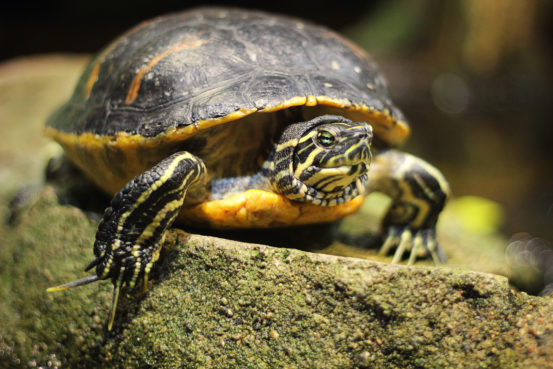
Yellow-bellied sliders are the most commonly seen turtle on the Outer Banks. Go to any freshwater pond and there will be dozens of them lazily swimming in the water just below the surface or basking in the sun on a log.
The shell usually has yellow markings on it, especially in juveniles. As they age the yellow on the carapace (shell) tends to fade, but all yellow-bellied sliders have yellow bellies—hence the name.
Two places to see them by the hundreds:
Sandy Run Park in Kitty Hawk, which is a wonderful little park—a perfect place to introduce even the youngest children to the outdoors.
The ADA trail at Nags Head Woods. The south end of this trail overlooks a freshwater pond. Some very large yellow-bellied sliders have been seen here.
Snapping Turtles
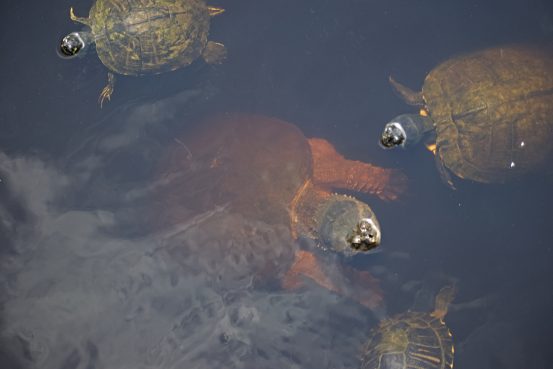
Pretty much unchanged for 90 million years, snapping turtles have a primordial, ancient look about them.
The largest North American freshwater turtle, snappers have a fearsome reputation as an aggressive predator just waiting to snap off the fingers of anyone who dangles a digit in front of them. When cornered on land they will defend themselves. In the water, though, they are noted for being docile and nonaggressive.
Snapping turtles are opportunistic feeders and will eat just about anything they can get to—insects, spiders, worms, fish, frogs, small turtles, snakes, birds, and small mammals. They also eat carrion and, in spite of their reputation, 30-40 percent of their diet is vegetation.
The pond at the beginning of the trail around the impound at Pea Island National Wildlife Refuge is usually teaming with snapping turtles. They also show up in almost any swamp or pond from time to time.
Eastern Box Turtle
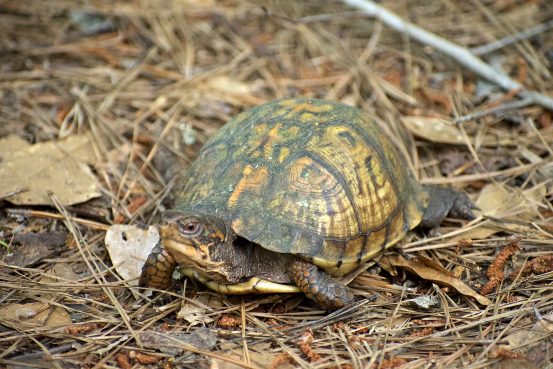
Rare to see one on the Outer Banks, but they are here. The Eastern Box Turtle may be the most commonly seen turtle in every place up and down the East Coast.
Northern Diamondback Terrapin
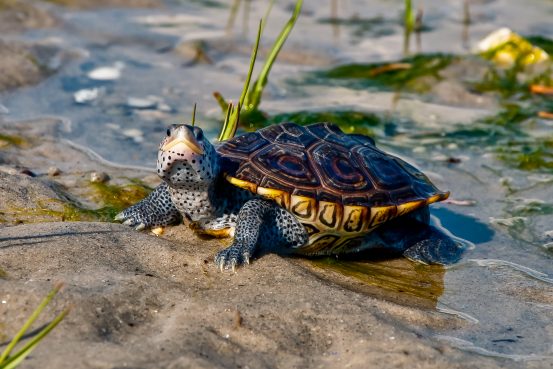
Fairly common on the Outer Banks, but living their lives in brackish to saltwater marshes keeps them out of view for most people.
Snakes and Others
Black Snake aka Rat Snake
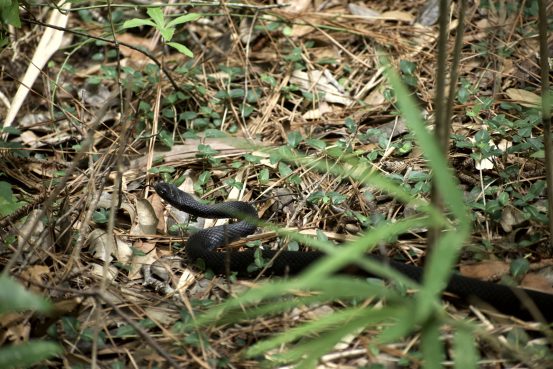
The black snake is our friend. There’s a good reason why it is also known as a rat snake—they eat mice and rodents.
A constrictor type of snake, black snakes are not poisonous. Adult snakes are between 3.5′ and 7’ in length.
They are good climbers and will hide in trees making them difficult to spot. Best chance to see one is on a sunny day when one of them may be sitting on a rock soaking up solar energy.
Cottonmouth/Water Moccasin
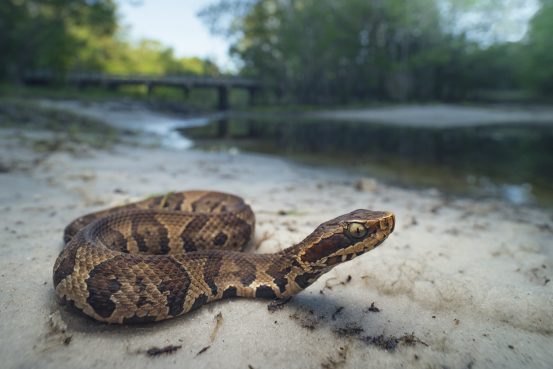
Yes, it’s a poisonous snake. And they can get pretty big—usually 3’-4’, but they can get up to 6’ in length.
But remember this—human beings are not their prey. As far as a cottonmouth is concerned, the less interaction with humans the better. If one is seen, leave it alone. They can be territorial; they get their name from one of their defensive strategies of opening their mouth and exposing the white lining of their mouth.
Cottonmouths are one of our most aquatic snakes, spending their time either in the water or immediately adjacent to it. They are often seen basking on a tree branch or beached by a freshwater source.
In spite of their reputation as pit vipers waiting to attack, they are very useful in controlling populations of rats, frogs, and other animals that would overrun everything if they weren’t around.
Copperhead
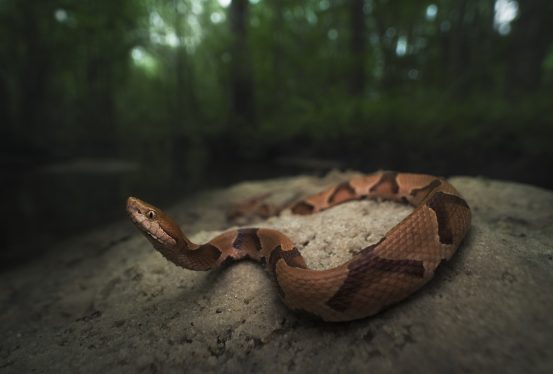
Not all that common around the Outer Banks, but they do show up from time to time. Copperheads prefer wooded areas over swamps and marsh.
They are pit vipers, but their poison is not considered particularly lethal. That being said, they are a pretty aggressive snake and are the most likely to attack if they feel threatened. They are also smaller snakes, very rarely getting over 4’ in length.
Around people they’ll take up residence in old wood piles or something similar.
Rough Green Snake
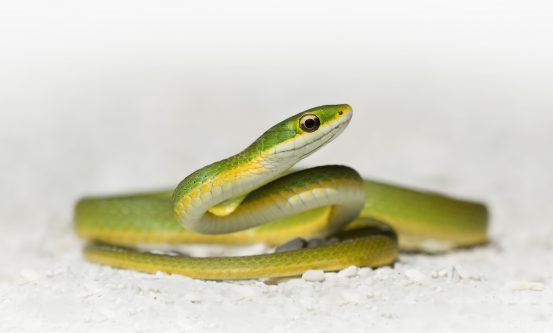
The Rough Green Snake are very common in this area but spotting one is difficult.
It’s a small snake, about 2’-2.5’ in length. It favors dense foliage close to a source of water. Because the color of the snake matches its environment, they are not easily seen.
Nor are they poisonous—in fact, the rough green snake is considered very gentle and calm when held.
Alligators
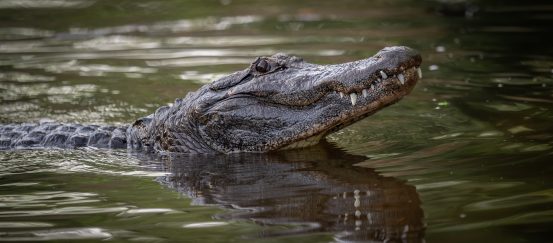
There is not much chance at all of seeing an alligator on the Outer Banks, but head over to Alligator River National Wildlife Refuge on the Dare County mainland, and there are hundreds of them there.
The refuge is at the northern end of the alligators’ range, although there have been some reports of alligators as far north as the Great Dismal Swamp.
Alligators at ARNWR appear to grow more slowly than those farther south, but they do get quite large. The biggest was an 800 pounder that was struck by a car in East Lake. If an alligator is ever seen on the Outer Banks—and there have not been any reliable reports of that, it would be one that swam across Albemarle Sound.
